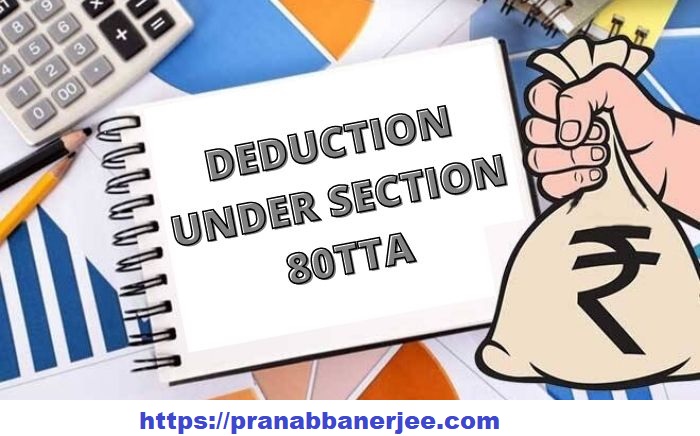A savings bank account is one of the most common financial tools that almost every individual holds. While it helps in keeping money safe and liquid, the interest earned on a savings account is not completely tax-free. According to the Income Tax Act, the interest is considered “Income from Other Sources” and is taxable. However, under the old tax regime, taxpayers can claim a valuable deduction under Section 80TTA.
In this detailed guide, we explain the deduction limit, eligibility, applicability, and process of claiming the 80TTA deduction. We also highlight important points, benefits, and differences between Section 80TTA and Section 80TTB so that you can maximise your tax savings.
Understanding Section 80TTA of the Income Tax Act
The Section 80TTA deduction was introduced to encourage small savings and provide relief to taxpayers who earn interest from their savings bank accounts. This provision applies only under the old tax regime.
- Deduction Limit: Taxpayers can claim a maximum deduction of ₹10,000 on the interest earned from their savings bank accounts.
- Applicability: Only interest from savings accounts is eligible. Interest from fixed deposits (FDs), recurring deposits (RDs), corporate bonds, or NBFC deposits is excluded.
- Eligibility: The deduction is available to individual taxpayers and Hindu Undivided Families (HUFs). However, Non-Resident Indians (NRIs) cannot claim this benefit.
- Institutions Covered: The deduction applies to interest earned from savings accounts maintained with:
- Banks
- Post offices
- Cooperative societies offering banking services
Difference Between Section 80TTA and Section 80TTB
It is crucial to distinguish between Section 80TTA and Section 80TTB, as both relate to deductions on interest income:
- Section 80TTA: Available for all individuals and HUFs, with a deduction limit of ₹10,000.
- Section 80TTB: Available exclusively for senior citizens (aged 60 and above), with a higher deduction limit of ₹50,000 on interest income from savings accounts, fixed deposits, and recurring deposits.
Therefore, taxpayers must select the right section based on their age and type of deposits to maximise tax relief.
Key Features of Section 80TTA
The deduction under Section 80TTA comes with specific features and conditions:
- Maximum Limit: You can reduce your taxable income by up to ₹10,000 from savings account interest. Even if your total interest exceeds this amount, only ₹10,000 can be deducted.
- No Age Restrictions: Unlike 80TTB, there is no age-based restriction. Any eligible taxpayer can claim it.
- Applicable Only in Old Tax Regime: If you opt for the new tax regime, this deduction cannot be claimed.
- Simplicity in Claiming: The process is straightforward, making it a beneficial and simple tax-saving tool for individuals.
Types of Interest Eligible and Ineligible Under Section 80TTA
To avoid mistakes while filing returns, you must know what qualifies for deduction:
Eligible Interest:
- Savings account interest from banks
- Savings account interest from post offices
- Savings account interest from cooperative societies
Ineligible Interest:
- Fixed deposit (FD) interest
- Recurring deposit (RD) interest
- Term deposit interest
- NBFC deposit interest
- Interest from corporate bonds and debentures
How to Claim Section 80TTA Deduction in Income Tax Return
Claiming this deduction requires accurate reporting of interest income in your Income Tax Return (ITR). Follow these steps:
- Collect Bank Statements: Compile all savings bank statements for the financial year to calculate total interest earned.
- Choose the Right ITR Form: Generally, individuals use ITR-1 or ITR-2 depending on income sources.
- Report Interest Income: Enter the interest earned under the head “Income from Other Sources.”
- Claim Deduction: Deduct up to ₹10,000 under Section 80TTA. Senior citizens can alternatively claim up to ₹50,000 under Section 80TTB.
- Fill in the Remaining Details: Complete the other sections of the ITR, including salary income, other deductions, and tax payments.
- Review and Submit: Verify all entries to avoid errors before submitting online.
Illustration of Section 80TTA Deduction
Suppose Mr. Sharma, aged 40, has earned:
- Savings bank interest: ₹12,000
- Fixed deposit interest: ₹25,000
In this case:
- Total interest income = ₹37,000
- Deduction under Section 80TTA = ₹10,000 (only for savings account interest)
- Taxable interest income = ₹27,000 (₹2,000 from savings account + ₹25,000 from FD)
Thus, Mr. Sharma can reduce his taxable income by ₹10,000 using Section 80TTA.
Important Points to Remember About Section 80TTA
When claiming this deduction, keep these critical points in mind:
- Applicable only to savings account interest.
- The deduction limit is capped at ₹10,000, irrespective of the total interest.
- NRIs cannot claim this deduction.
- Not available in the new tax regime.
- Senior citizens should prefer Section 80TTB for higher deduction benefits.
Benefits of Section 80TTA Deduction
The 80TTA deduction offers multiple advantages to taxpayers:
- Reduced Tax Liability: By lowering taxable income, it directly decreases the total tax payable.
- Encourages Small Savings: Motivates individuals to save money in their bank accounts rather than keeping it idle.
- Simple to Avail: Requires no special documentation apart from bank statements, making the process hassle-free.
- Widely Applicable: Beneficial for a majority of taxpayers who maintain savings accounts.
Section 80TTA Under Old vs New Tax Regime
- Old Tax Regime: Taxpayers can avail deductions under 80C, 80D, 80TTA, and others. Section 80TTA is valid here.
- New Tax Regime: Lower tax rates, but no deductions like 80TTA are allowed. Taxpayers must carefully evaluate which regime results in greater savings.
Conclusion
The Section 80TTA deduction plays a vital role in reducing tax burdens on individuals and HUFs earning interest income from savings bank accounts. With a deduction limit of ₹10,000, it provides a simple yet effective way to optimise tax savings under the old tax regime. By understanding eligibility, reporting requirements, and differences with Section 80TTB, taxpayers can make informed choices and legally minimise their tax liability.
If you manage your savings account effectively and claim the right deductions, you can ensure that your hard-earned money stays with you rather than going unnecessarily towards taxes.





